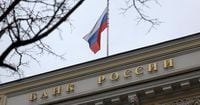As of April 1, 2025, the Central Bank of the Russian Federation has officially set the exchange rates for foreign currencies, marking a significant shift in the financial landscape. The dollar is now valued at 85.4963 rubles, while the euro stands at 92.4276 rubles. This adjustment reflects a rise of 1 ruble 82 kopecks for the dollar, which translates to an increase of 2.13%. However, since the beginning of March, the dollar has weakened by 2 rubles 76 kopecks.
In a parallel movement, the ruble has also depreciated against the euro, which has risen by 2 rubles 77 kopecks, amounting to a 3% increase. The euro’s value has increased by 86 kopecks since the start of the month. The cross-rate for EUR/USD is currently set at 1.0811, meaning one dollar is equivalent to 0.925 euros.
The recent changes in the currency market come on the heels of a tumultuous period for the Russian economy. The dollar exchange rate was raised from 83.6813 rubles to 85.4963 rubles, and the euro was similarly adjusted from 89.6553 rubles to 92.4276 rubles. Additionally, the Bank of Russia has increased the official yuan exchange rate from 11.4575 rubles to 11.7136 rubles.
These fluctuations are partly attributed to sanctions imposed by the U.S. Department of the Treasury against the Moscow Exchange on July 12, 2024. This action led to the suspension of exchange trading in dollars and euros, which has since been transferred to the over-the-counter market. The Central Bank establishes official exchange rates on weekdays based on bank reporting and information from these over-the-counter transactions.
In March 2025, the ruble had shown signs of strength, with the dollar’s exchange rate decreasing by 4.5% to 83.68 rubles per dollar by March 29. Analysts noted that this strengthening was influenced by several factors, including a seasonal decline in import activity and increased sales of foreign exchange earnings by major exporters.
According to reports, in February, exporters sold 25% more currency compared to January, totaling around $12.4 billion. This surge in sales was a response to growing demand for ruble assets, fueled by rising expectations of decreased geopolitical tensions. Analysts from Vedomosti indicated that the tightening of monetary conditions has also played a role in limiting demand for foreign currency.
As the Russian economy continues to navigate these challenges, the recent adjustments in currency values highlight the ongoing volatility and the influence of external factors on the domestic market. The Central Bank’s decisions are closely monitored by financial experts and traders alike, as they reflect broader economic trends and shifts in investor sentiment.
In summary, the official exchange rates set by the Central Bank of Russia as of April 1, 2025, indicate a complex interplay of factors affecting the ruble, dollar, euro, and yuan. The market remains sensitive to geopolitical developments and economic policies, which are likely to continue shaping the financial landscape in the coming months.



